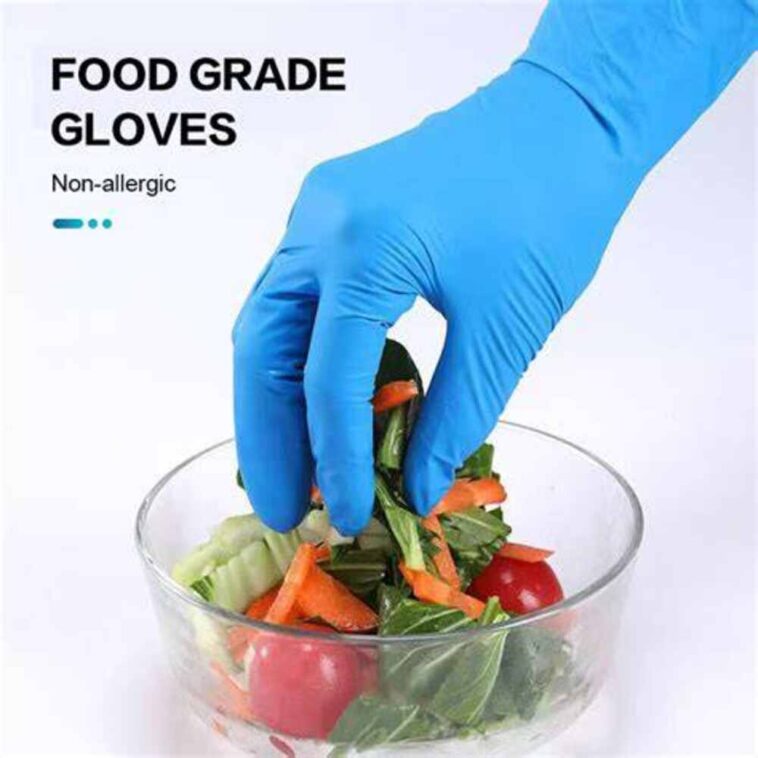When it comes to food preparation, safety is everything. Whether you’re a professional chef, a restaurant worker, or someone cooking at home, preventing contamination should always be a top priority. One of the simplest yet most effective tools in maintaining food safety is the disposable glove. But using gloves the right way is just as important as wearing them. Here’s what you should know about how disposable gloves help keep food safe — and how to use them properly.
1. Why Food Safety Matters
Food safety isn’t just about following rules — it’s about protecting people. Contaminated food can cause foodborne illnesses such as salmonella, E. coli, or norovirus, which can have serious health consequences. According to the World Health Organization (WHO), millions of people fall sick each year due to unsafe food handling practices.
Simple precautions, like maintaining cleanliness and avoiding cross-contamination, can make a huge difference. This is where disposable gloves come in — they act as a barrier between your hands and the food, reducing the risk of transferring bacteria or viruses.
2. The Role of Disposable Gloves in Food Handling
Disposable gloves are designed to protect both the food and the person preparing it. They prevent oils, sweat, and germs from your hands from coming into contact with food surfaces. In commercial kitchens, where multiple people handle ingredients, gloves play an essential role in hygiene control.
- There are several types of disposable gloves used in the food industry:
- Nitrile Gloves: Durable, latex-free, and resistant to punctures — ideal for those with latex allergies.
- Vinyl Gloves: Economical and comfortable for short-term use, but less durable than nitrile.
- Polyethylene Gloves: Lightweight and perfect for quick food service tasks such as sandwich or salad preparation.
- Latex Gloves: Flexible and comfortable but can trigger allergic reactions in some individuals.
Each type serves a different purpose, so choosing the right glove depends on the task and the user’s needs.
3. Proper Glove Use: More Than Just Wearing Them
Wearing gloves doesn’t automatically guarantee food safety. In fact, improper glove use can spread more germs than clean hands. The key is to use them correctly.
Here are a few essential tips:
Wash your hands before putting on gloves. Gloves are not a substitute for handwashing.
Change gloves frequently. Always replace gloves after handling raw meat, touching your face, or switching between different food items.
Never reuse disposable gloves. They are designed for one-time use only.
Avoid touching non-food surfaces. Handling phones, door handles, or cash while wearing gloves can cause contamination.
By following these steps, you ensure that gloves remain a tool for protection, not a source of contamination.
4. Food Safety Regulations and Best Practices
Most countries have strict food safety standards that require proper glove use in food preparation environments. Agencies such as the U.S. Food and Drug Administration (FDA) and European Food Safety Authority (EFSA) recommend disposable gloves as part of a comprehensive hygiene plan.
However, compliance isn’t just about following regulations — it’s about building trust with customers. In today’s food industry, cleanliness and safety are directly linked to reputation. Restaurants and catering businesses that prioritize hygiene are more likely to gain loyal customers and positive reviews.
For businesses, implementing regular staff training on glove use and hygiene protocols is essential to maintaining consistent safety standards.
5. Balancing Safety and Sustainability
While disposable gloves are crucial for hygiene, they also raise environmental concerns. Many gloves are made from synthetic materials like nitrile or vinyl, which take years to decompose. The good news is that eco-friendly alternatives are becoming more available.
Some manufacturers now produce biodegradable nitrile gloves or gloves made from plant-based materials. Businesses can also minimize waste by choosing the right glove for each task — using thicker, longer-lasting options when appropriate and lighter ones for short-term jobs.
Balancing safety and sustainability ensures that we protect both public health and the environment.
6. Choosing the Right Disposable Gloves
When selecting disposable gloves for food handling, consider these factors:
- Material: Choose gloves that are food-safe and suitable for your specific tasks.
- Fit and Comfort: Properly fitted gloves prevent tearing and improve dexterity.
- Allergies: Opt for latex-free gloves to avoid allergic reactions among workers.
Certification: Look for gloves that meet food safety standards such as FDA-approved or EN 1186 compliant.
Investing in high-quality gloves not only improves safety but also enhances productivity by allowing staff to work efficiently and confidently.
7. Final Thoughts
Disposable gloves are an essential part of modern food safety practices. They help prevent contamination, protect consumers, and promote professional hygiene standards in every kitchen. However, their effectiveness depends on how they’re used.
By combining proper glove usage with good hygiene habits — including regular handwashing, surface cleaning, and food separation — you can significantly reduce the risk of foodborne illness.
In the end, food safety isn’t just about following regulations; it’s about caring for the people who eat the food you prepare. And with the right disposable gloves, that’s a responsibility you can handle safely, efficiently, and responsibly.
Article by: https://mitrasaruta.com
This post was created with our nice and easy submission form. Create your post!





